During the back to school season, one of the biggest concerns or questions I continue to see pop up in FB groups and across the internet is “I was moved to TK from (insert another grade level here) now what!!”
And first I want to say, welcome to the world’s greatest grade in my honest opinion!
The growth and learning that takes place in the TK year is phenomenal. You will see your young students go from first-timers. Those leaving their parents to confident, strong learners that develop socially, emotionally, and academically over the course of 180 short days.
For those that may not have TK, UTK, PreK4, K4, or transitional kindergarten in their area. This post applies to all teachers and students aged 4-6ish or entering a traditional school or program for the first time. (Welcome to all my Child Care Providers, Early Ed Teachers, and Classroom Teachers- you are seen here!)
Now on to setting up your own classroom for a successful year!
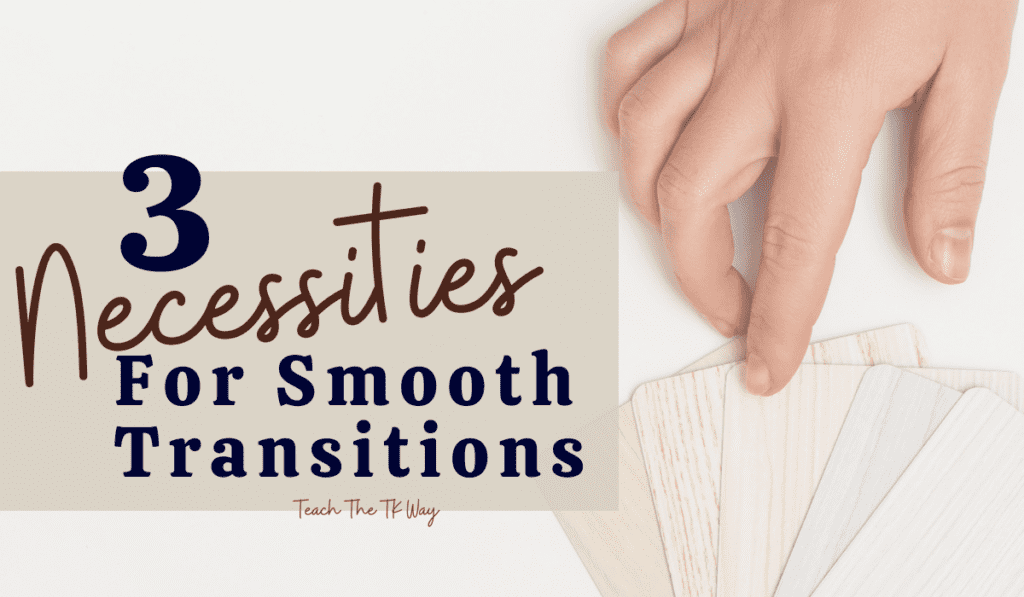
3 Necessities For Smooth Transitions- Not Just for Back to School
When creating your daily schedule, it is also important to provide a healthy balance for children. Find a way to advocate for dividing time between group activities and more solitary moments, large and small motor activities, and indoor and outdoor play.
Transition times are important because they can make the day seem smooth and well-organized, or rushed and out of sorts- students and teachers alike. Too many transitions and you’ll upset the delicate balance of harmony in the first few weeks especially. In many other grades, the day will still progress if you drop everything for a specials class or pull out for an activity like PE.
But in TK the first few weeks should be protected to learn a regular schedule without interruptions.
What do you need to create smooth transitions, the first day of school and beyond?
- Flexible Daily Schedule: One that allows you to switch it up if needed. Yes, lunch and recess may be at a specific time, but if you need to get outside earlier, find out the expectations for your grade level.
- Plenty of Time for Movement Activities: songs, fingerplays, and outdoor learning are all going to be your friend in the first few days and weeks. Some children may not realize they are sensory seekers, but rather than always trying to manage the behaviors grab some bean bags and play some games!
- A backup plan: most things in TK only take 2-5 minutes, especially in the first few days of school as they develop stamina. So have a plan for when something does go the ay you think it should. Music at the ready, a special basket of manipulatives that you can pull out at a moments notice. And most importantly something that will interest the students while you regroup.
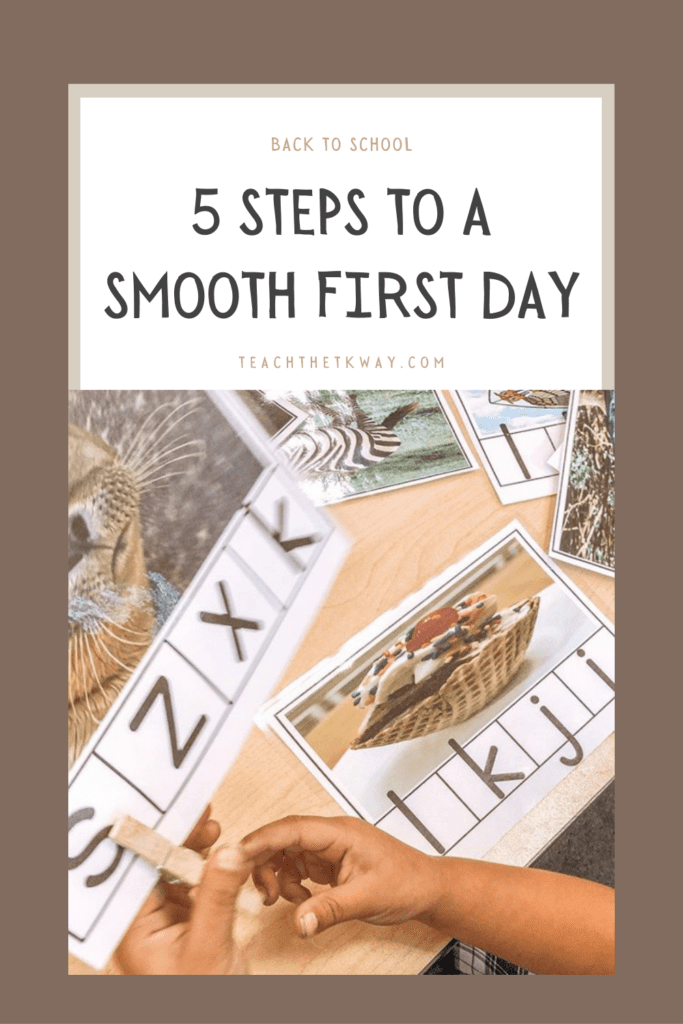
Back To School Quick Start Guide For A Smooth First Day
As you begin to prep for your teacher work days here is your quick start guide to a smooth back to school season.
Printed Nametags:
Preferably with an icon so children can match. Many may not know how to read their names yet. And many go by a nickname, so reach out to parents early and ask what they would like on their child’s nametag. Have a space where the children know they can find theirs to put on each day. This also helps any adult on the playground know which class they belong to, and their name depending on what your recess schedule looks like.
Class list:
In my experience, this changes regularly and up to the last minute. But if being prepared is your love language ask for one ahead of time so you can establish a connection with the parents sooner rather than later. Send a welcome email or video so the children can “see” you before the first day of school.
Cubby area or backpack drop zone:
Decide what you have the space for first of all, and then communicate to families and caregivers what your expectations are before they go back to school shopping for the Paw Patrol backpacks, Binders, Pencil cases, and more.
Bathroom Procedures:
How will you tackle them? Is the bathroom in your building, the actual classroom, or somewhere else? What is the plan in case of accidents (because they can and do happen)? Where will extra clothes live? Open the conversation between yourself and support staff BEFORE the first day of school.
Drop off and Pick Up procedures:
Just like with the bathroom, many times crying happens. Sometimes it’s the child and sometimes it’s the parent. Either way, have a plan for what you expect at drop off and pick up. Then communicate with families, caregivers, and school staff PRIOR to the first day of school.
Great First Day Activities for Prek, TK, and Kinder
So many people want to suggest books that might work in Kindergarten. Books like Chrysanthemum discuss the importance of names. Or even The Kissing Hand to help the worries go away. But 26 years taught me that young students won’t have an attention span for books that long in the first few weeks.
Instead, I like to read short stories that will lead us to a learning activity:
- If You Find A Rock: after you read go on a rock hunt around your schoolyard.
- Stick and Stone: start the year off with some rhyme and finding friends in new situations
- Not a Box: bring in a real large box and work together in the art space to turn it into something fabulous.
- Whoever you are: after you read graph some favorites including math in your literacy block (ice cream flavors, sports, classroom activities) so children can see how alike they really are.
- Outside In: after you read go on an outdoor walk, take a sheet of paper, and draw what you see.
- Explorers of the Wild: head to the science and art area to make paper binoculars. Then bring them back to the meeting area and sing going on a bear hunt. And take them outside and go exploring.
More early literacy activities can be found here.
Additional Hands-on Math Activities throughout the year.
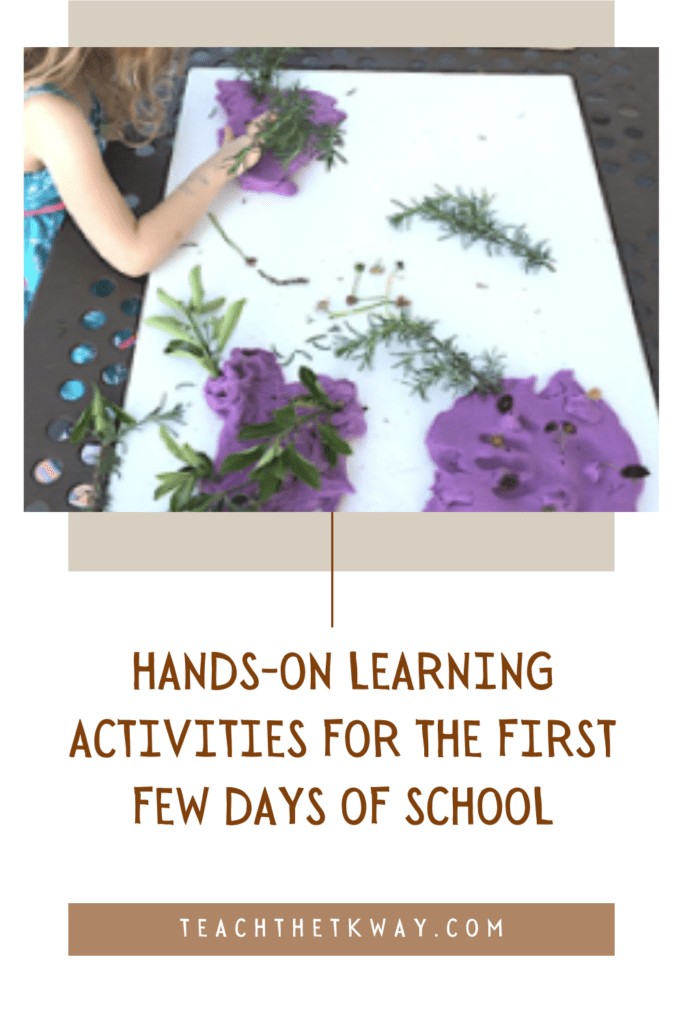
Hands-On Learning Activities To Do The First Few Days Of School
When you start a new school year the first few weeks really are about learning what your students are capable of. What their interests are. And how they learn best. So offering activities that anyone can do no matter the ability level is a great way to get started assessing.
Bead Bracelets: pipe cleaners and pony beads for some fine motor fun.
Playdoh: I love to add scissors to the playdoh area so I can assess cutting. But be sure to go over scissor expectations BEFORE you offer them in the learning center.
Loose parts: exploring the next math manipulative before you apply counting patterning and academic concepts to the learning. Allow your students to just enjoy the materials they may not have access to.
Flannel stories: allow children to retell stories they are familiar with already. Create some flannel stories for things like The 3 Bears (size seriation), Brown Bear Brown Bear (colors), and 5 Green and Speckled Frogs (math).
Bubbles: a great stress relief, sensory exploration, plus a breath regulator for anyone who may have spent some time crying or upset.
Sensory tub: The first few weeks can be as simple as water if it’s hot. With scoops, pipettes, turkey basters, and colanders. Or add some shredded paper with magnetic alphabet letters, magnet wands, and a cookie sheet (from the dollar tree). When the children find the letters they can place them on the cookie sheet.
Creating an Intentional Classroom Environment on a Budget
Teachers have been seeing the importance of moving away from rainbow-colored overly stimulating spaces. Spending all of your time putting up commercially purchased bulletin board cutouts that will amp up behaviors before students ever even enter the room.
Brain research tells us that children are unable to visually process a multitude of colors and stay on task. Teachers are now using this advanced research to design spaces that support student learning on an emotional level, as well as an academic one. Instead, teachers are salvaging items from home, Goodwill, and grandma’s attic to incorporate authentic materials in their learning spaces.
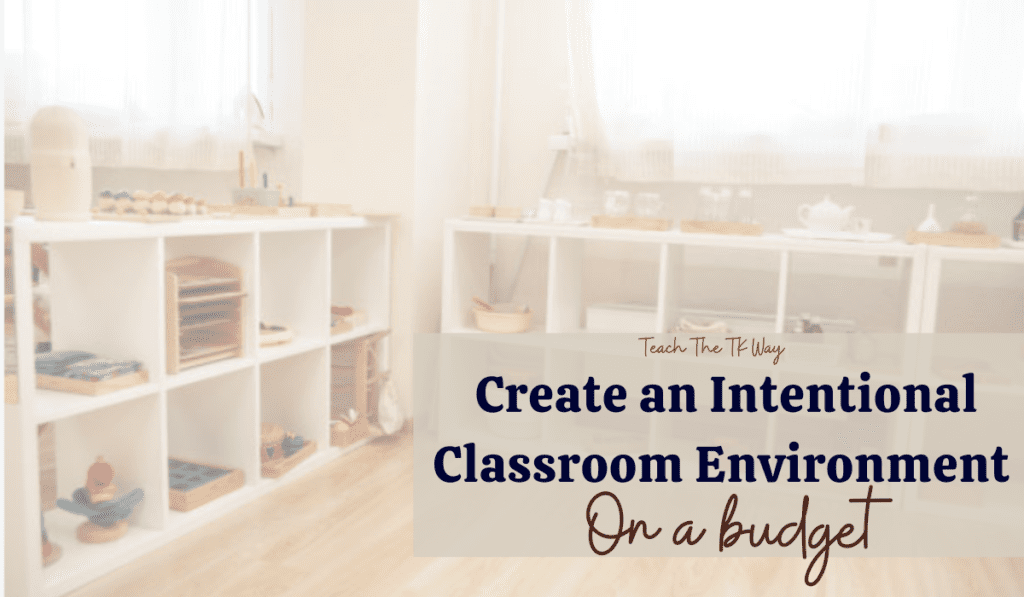
When creating a classroom environment with young students think GROUP materials. Many times if you have individual pencil boxes or materials, just getting into a box can cause stress.
My top suggestions for materials to start the year here:
- Tables and child-sized chairs versus desks whenever possible. Young students struggle to sit at a desk, need space to move around, and tables give you more area to tackle large projects.
- Mason jars (or some similar storage option): pencils, paintbrushes, markers, glue sticks, scissors. This way you can pull the whole jar to the table and let students choose their tools.
- Individual clipboards. Love these for large group activities. And students can use them to move around the room to “practice write the room lessons”. Or they can use them in the block center to record their structures. Drag them into math and draw patterns, etc.
- Cubbies or backpack hooks. Whichever works for your space. Start the year organized so the students can learn the routine quickly.
- Label everything. I love to take pictures of the manipulatives and attach them to the shelves and containers with velcro. This allows students to see at a glance where something can be returned to during clean-up.
How to Manage Behaviors and Crying Jags
Ready to learn the secret magic recipe for classroom management, during the back to school season and beyond? Design a space that will help keep challenging behaviors at a minimum. I am here to tell you that they will cry. It happens, they are young, and many have never been away from their immediate circle before. And now they are expected to follow directions and fit a traditional program mold.
Show grace and understanding. Have some clear rules (mine was always- you can be sad/mad/angry/scared- but you cannot go out of the classroom door without me.) Clear and concise. If the parent gave me a heads up I would ask for some of the support staff in the first few days to help keep an eye on the exits during our first transitions.
Just know it is a season, and it will end. Usually within the first few minutes of the day. In the event that it lasts longer, once the child is content, happy, or engaged in an activity sending a pic to the family can allay their fears too.
Do remind the parents that a quick goodbye is best. Not to skip out without saying goodbye, because that creates unnecessary anxiety. And make sure if you have windows near the exit the blinds stay down for the first few days during drop off. Ask the parents not to hang out outside the door to help with the transition into the classroom.
Incorporating a special back to school season schedule with young students
One of the things I realized in working in a traditional school was that there can be many schedules to work through. And usually, TK isn’t super high on the list, mainly because middle schoolers have to fulfill a specific amount of instructional minutes. So in the case you are able to have some time with the librarian, computer specialist, Spanish teacher, etc. ask that they come to you. At least for the first few weeks.
For the first few weeks of the back to school season it takes a long time to line everyone up, get them all to use the bathroom, and get to a new classroom. Just to turn around and head back after a few songs or a single book. You can get more from staying in your space and having the adult come to you until you know your students are settled into their routines.
Bonus back to school first-week example schedule for half days
8-8:10: Greeting, drop off, name tags, put away lunches, etc.
8:10-8:30: Morning Meeting, story, song, daily agenda
8:30-9:00: Recess, bathroom break, snack
9:00-10:00: Learning centers
10:00-10:40: Music and Movement, songs, bathroom break, bean bags, scarves, etc.
10:40-11:30: free choose activities
11:30-11:50: Outdoor Activities, recess, snack
11:50-12:00: pack up and dismissal
And remember these times are FLEXIBLE. But this back to school season schedule should suffice for any admin needing something in writing.
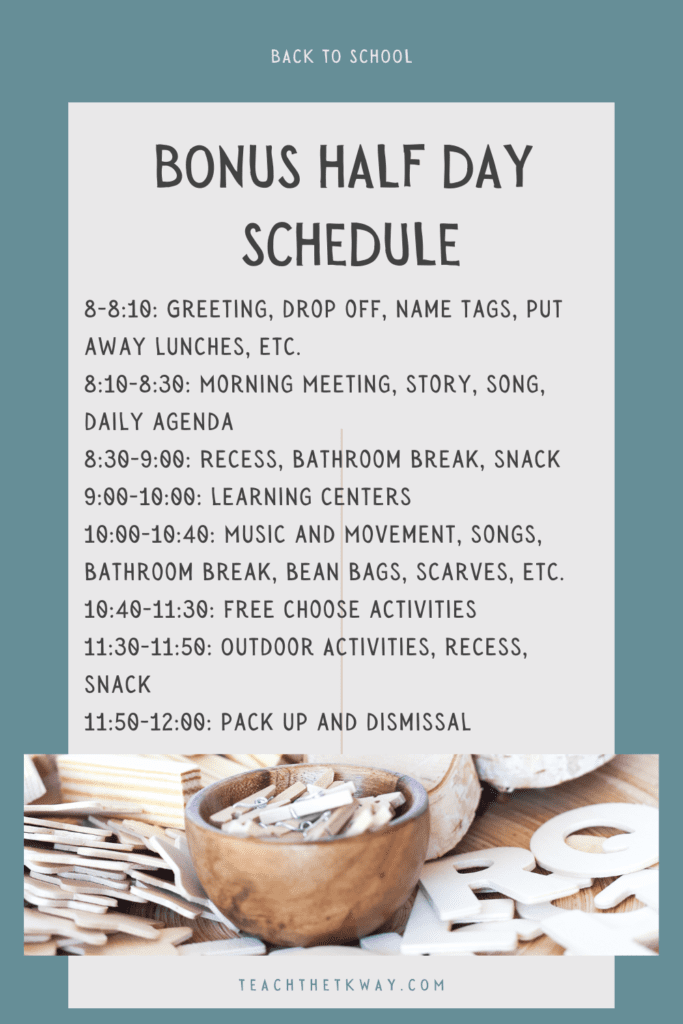
Undoubtedly there are so many more nuanced, specific-to-you items that will need to be worked through during the back to school season. But I know that if you take your love of education and leverage it with what you know about children and their learning styles. Throw in some grace and patience you are sure to have the best year ever!
First Week of Prek Activities Necessities Bundle
Grab the bundle that is going to save you time and energy setting up your nature-inspired space. Everything you need from ABC cards, matching games, number lines, class decor and even a parent meeting PDF. All you have to do is print, laminate, and get set up for the back to school season before the end of your first teacher work day.
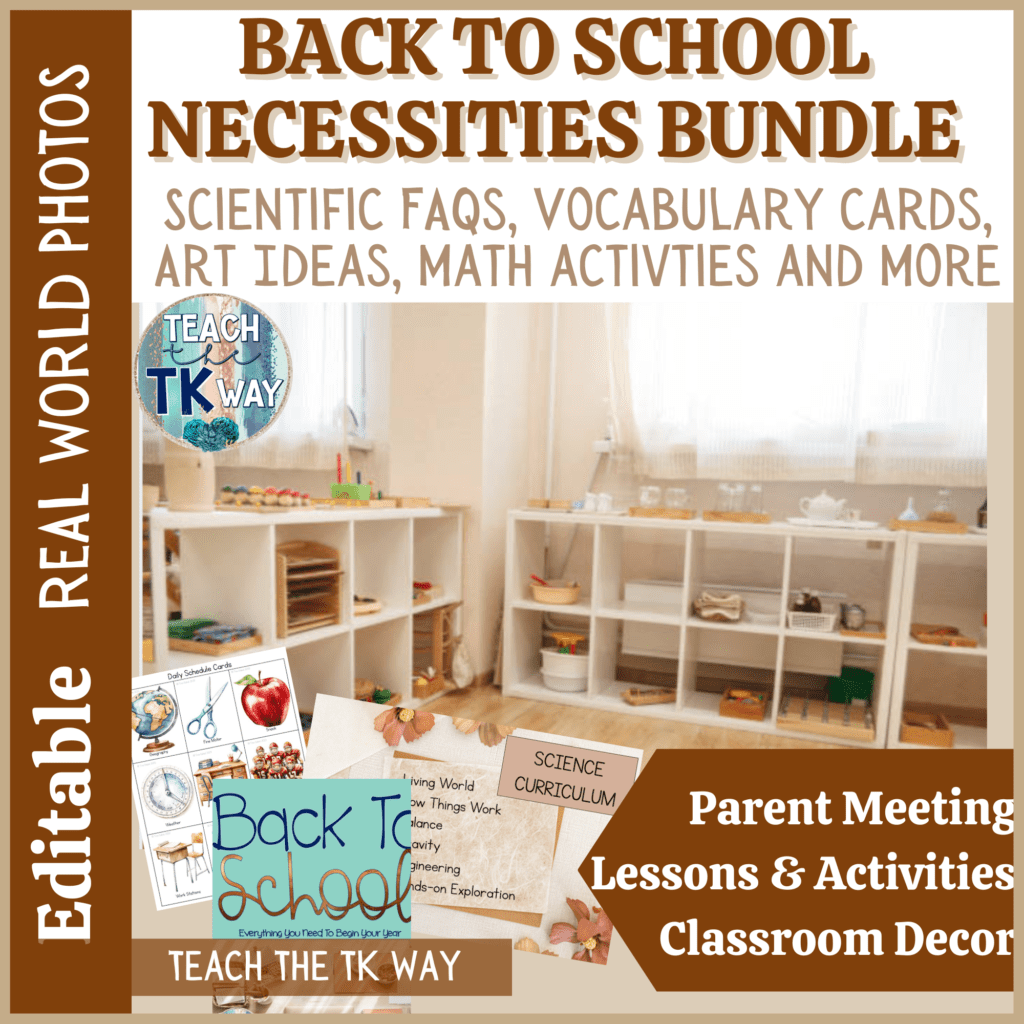

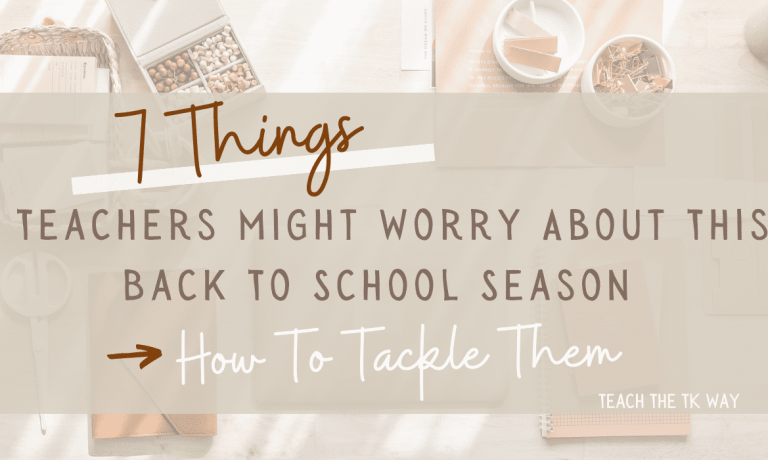

One Response
I love your blog post! It is so well done!